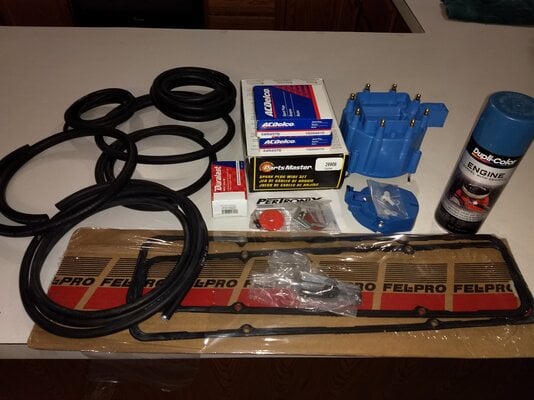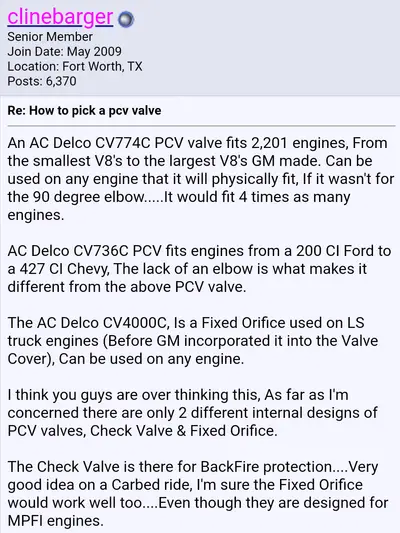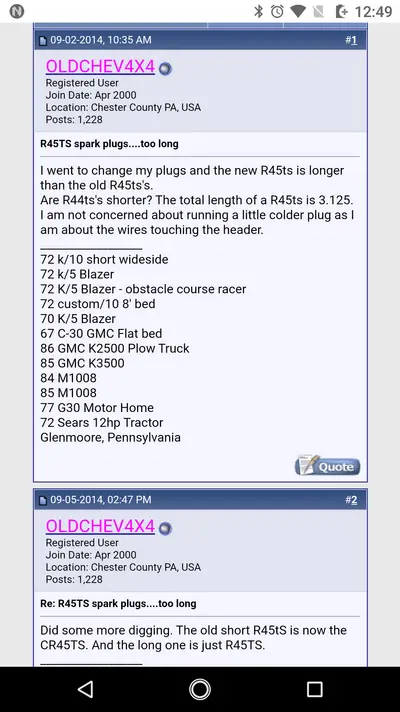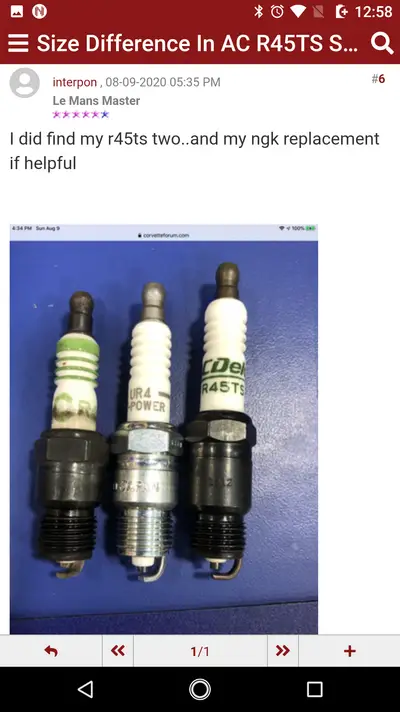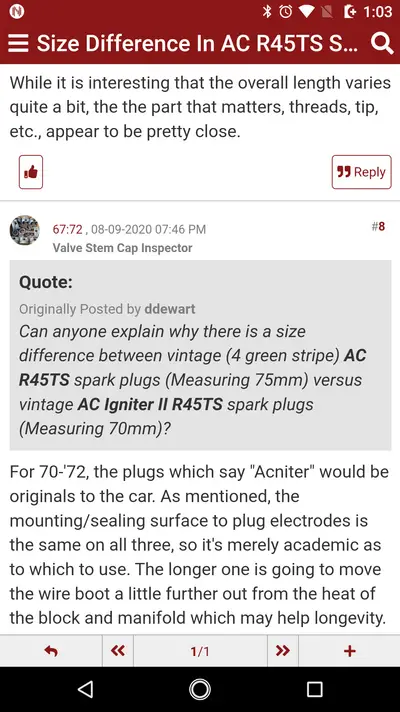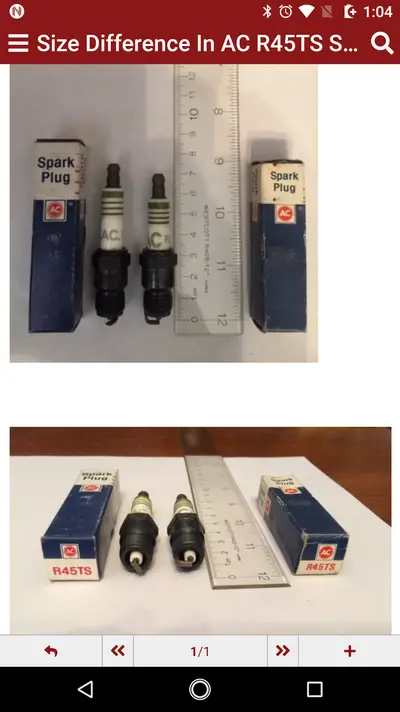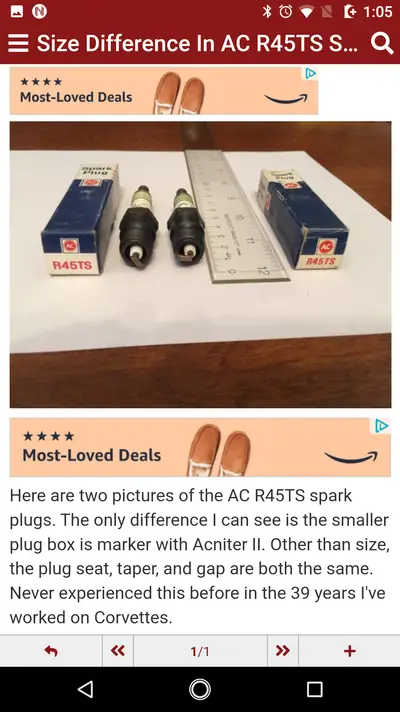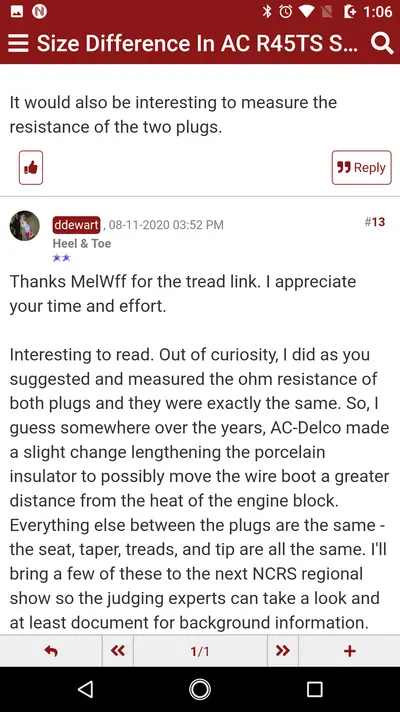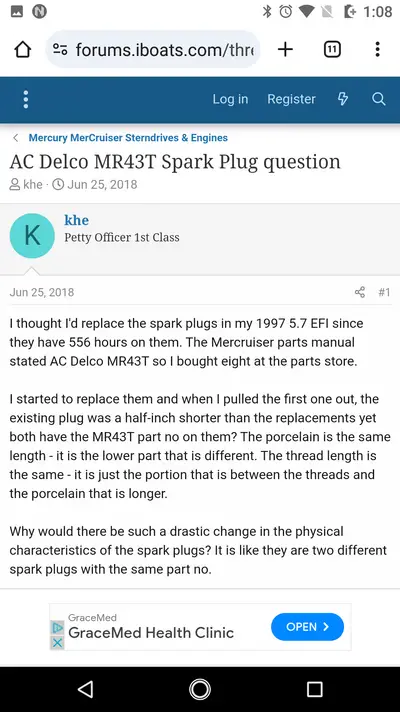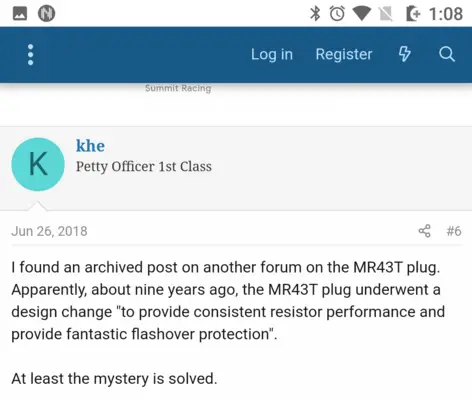I removed the spark plug wires as complete sets and laid them on the floor, followed by the plugs which were laid in their corresponding places. Driver's side on the left in this photo.
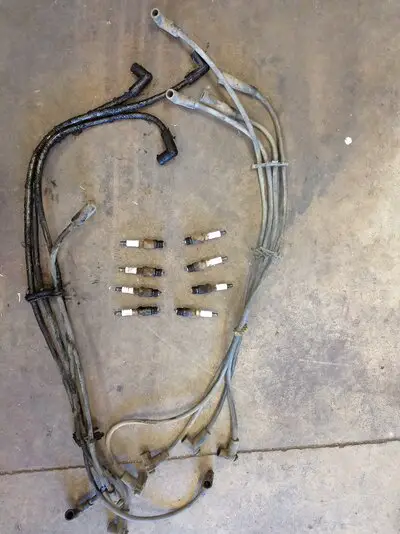
Here's a couple closer pics of the plugs, driver's side is on the right in these photos.
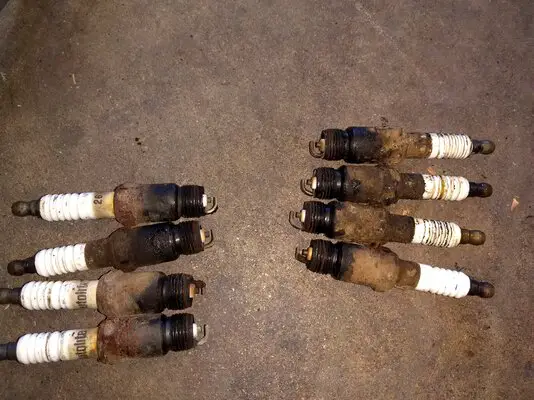
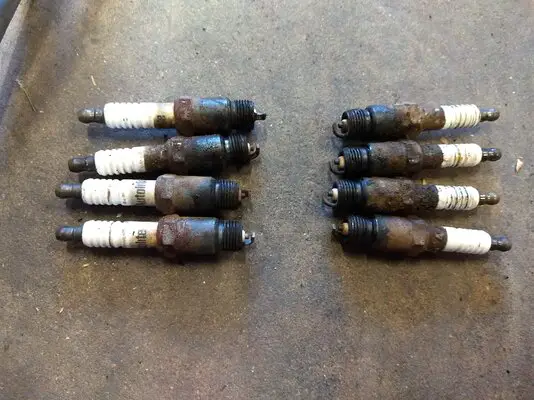
The new plugs came pre-gapped around .040 and the book called for 0.045 but I went with 0.50 for a bigger spark/ flame kernel. You can start damaging your stock HEI components if you go over 0.060 even though GM called for as much as 0.080 before they learned that lesson the hard way. I first spread the plugs wider with the traditional keychain gapper, then used feeler gauges and a much more precise tool to compress the ground strap until I reached my desired gap.
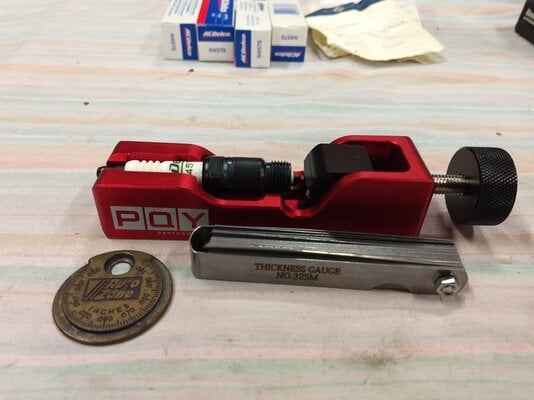
Here's the piece I've yet to replace, the rubber loom for the driver's side plug wires. I haven't seen any on the shelves nor have I received any looms with my plug wires, and I'd like to find one but will admit I haven't looked online at all. This one disintegrated when I tried separating it from the wires.
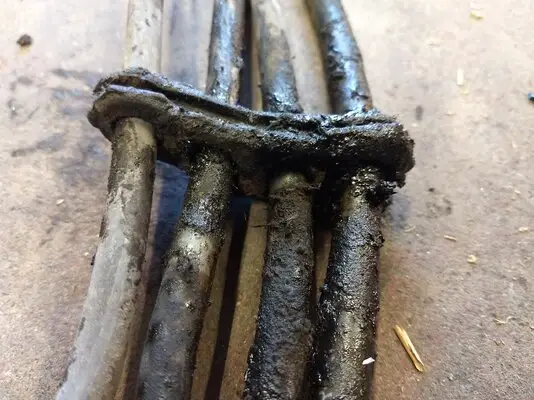
It slides into this "fork" behind and below the valve cover. It's a little hard to see in this picture, but it's the wide grooved item just to the right of the exhaust manifold.
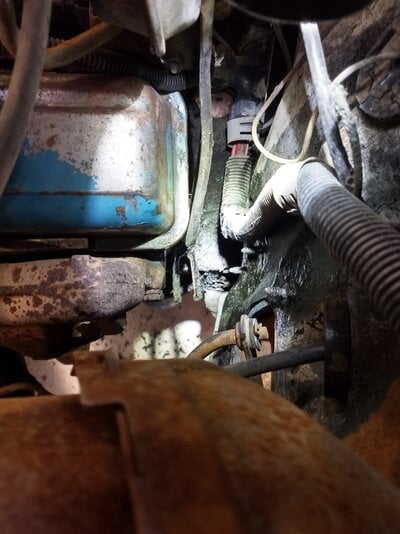
Following the installation of the plugs and wires I proceeded to clean and mark the harmonic damper and remove all of the snot from the timing tab as well. This allowed me to actually set the timing visually instead of just by ear, and though it calls for 4°BTDC I have it at 7° initial, total timing is currently unknown. I also temporarily connected a trustworthy AutoGage tachometer since my gauges indicate that Gina idles at 2,200 in park and 1,800 in gear, and was happy to see that my guess of 1K in park and 600 in gear was damn near spot on. I'd tweaked the idle speed adjustment and disconnected the fast idle solenoid in attempts to lower the RPMs since I could tell it was higher than I wanted, but wasn't exactly sure where we were until now. She's right at 1K in park if the throttle sticks (which is almost always), gets down to 850-900 if I wiggle it, and sits at a steady 650 RPM in gear at operating temperature. The fast idle solenoid seems to get us to about 1100 or so, and it has been reconnected.
After this the plan was to do the cap and rotor as well as clean and regrease the ignition module and lube the advance mechanism. But before I changed anything else I wanted to drive the car and see what effect new plugs and wires had. Gina definitely had more power yet was absolutely falling down repeatedly throughout the powerband, but if I continued to drive like an old lady things were just fine. This was the first time that she had enough juice to push me back in my seat but it was sporadic. She'd stand up and lay down over and over again at various RPMs- it was consistently inconsistent, yet I could force it to happen. I was unable to make it through an entire gear at 3/4 throttle before she'd cough and perk right back up, then hang, then take off again.
It was late and dark so I called it quits, planning to get right back at it just as soon as I had the chance. The carb needs rebuilt and I wasn't done with the ignition yet so I wasn't terribly worried about the way she was running, which was was better than before with a few exceptions. Maybe the mechanical ignition advance was hanging up and I never knew because before changing the plugs it only ever had 1/2 the power it should have. Regardless of how much you depressed the pedal you weren't passing anything quickly, before or after new spark plugs.
At this point progress was very slow due to work, the weather, and the holiday, and the cap/rotor and valve cover gaskets have yet to be replaced. Gina absolutely hates the cold weather and now requires starting fluid every time just to get going, she also occasionally dies. I chalked this up to the weather combined with a finicky carb and possibly the ignition, and the weather dictated that I drove to and from work at 25 mph using a propane torch every 2 minutes to keep ice from forming. Driving 20 miles of surface streets took me nearly an hour and a half. I also had to run an extension cord out to the car and leave a hairdryer running inside as the engine warmed and I got ready in the morning. It snowed for 12 straight hours and nothing was done to the roads until days after when it was already melting away.
I soon discovered that a main hurdle to getting the engine started was the fact that the fuel bowl keeps drying up. I verified this by removing the line and nothing coming out. A dry fuel bowl combined with what could logically be a lack of fuel under various load conditions led me to believe that the fuel pump I bought was potentially bad. Or maybe the fuel pump eccentric on my camshaft was getting wiped. Since parts store pumps are all cheaply made (by only 2 companies until Airtex went under, now I think it's just 1) and they started staking the rocker pivots instead of driving a solid pin all the way through it wasn't hard to imagine that I got one with a bad diaphragm or valves with bad tolerances. At a cost of around $20 I decided to just buy one without even testing the old one until later.
I went back to my preferred parts store after calling to ensure they had the correct Carter fuel pump and Fel Pro gaskets. They did, I bought 'em, and they're now on the car.
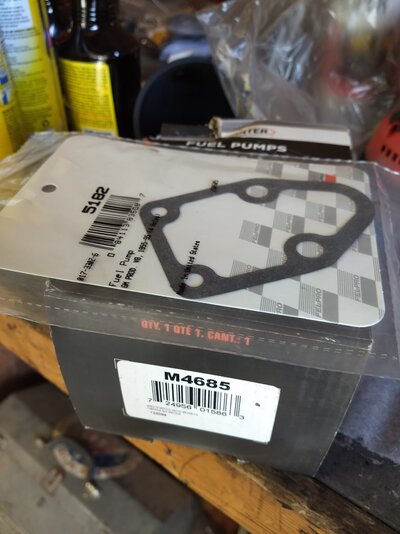
The Carter M4685 mechanical fuel pump outputs 40gph at a maximum of 7 psi, and it has only 2 ports. There is no return line.
After installation I wanted to take her for a drive after seeing if she'd die from simply idling. That's been happening more and more, especially when in gear. She passed the test but gave me trouble before I made it out of the neighborhood. I was really low on gas so I decided to chance the trip to the station 9 miles away in Derby so I could continue the test & tune session. It wasn't exactly a fun trip and I prayed that the tank didn't run dry while waiting on a train or traffic light, both of which are up a nice hill. I got past those, turned onto the 4 lane highway, and I ran out of gas (or died with 1/8 tank) then coasted into the center pump at the gas station. Lucky!!
I added 5 gallons and started back towards the house to continue working but had trouble immediately. There was definitely a major problem at hand and I had to do everything I could to keep Gina alive and not stall out. This meant I had to keep the RPMs above 1500 (actual) at all times, accelerate extremely slowly, and not try to go over 45 mph or exceed 3k. That was worse than the trip TO the gas station! Gina ended up dying twice on the journey home. What in the world was going on? I had an idea...
When I pulled up to the garage I immediately popped the hood with Gina still idling in Park so I could check something. Since I'd just came to a complete stop then the fuel bowl should be full and I
should be able to pinch the rubber feed line to the pump with no effect. It closed obscenely easily and she died. Aha.
That's it, that's what it is: she's starving. If the engine is barely being fed enough fuel from a brand new Carter pump that I pressure checked with compressed air then it's only 1 of 2 things. Either the cam lobe is nearly gone or the pickup tube/ pre-screen filter (a.k.a. fuel sock) is clogged. I removed the gas cap and rubber line from the pump and blew compressed air back into the tank to try and clear any obstructions. I then used a rag wrapped around the air nozzle to act as a gasket and blew air into the tank to send fuel back to the engine bay. Try it, it works. It just takes a few seconds to pressurize the tank and force the fuel to defy gravity.
I reconnected the line, put the cap back on the tank, and took her for a spin after a few squirts of starting fluid. Keeping her at 2k got me out of the neighborhood fairly quickly, and once I hit pavement I hit the pedal. And holy smokes, she left rubber behind!!! And promptly died.
Ladies and gentlemen I believe I have 2 separate problems. The fuel is draining from the carb bowl but is not going into my oil and it's definitely not squeaking by the valves and returning to the tank. It's dripping right into the intake, which explains a couple other very minor things. The second problem appears to be a very dirty gas tank with a clogged fuel pickup point, as repeatedly proven in various ways. So instead of changing out a heater core tomorrow I'll be dropping the tank. At least it only has 5 gallons in it.
Now you're all caught up. Well, almost.


